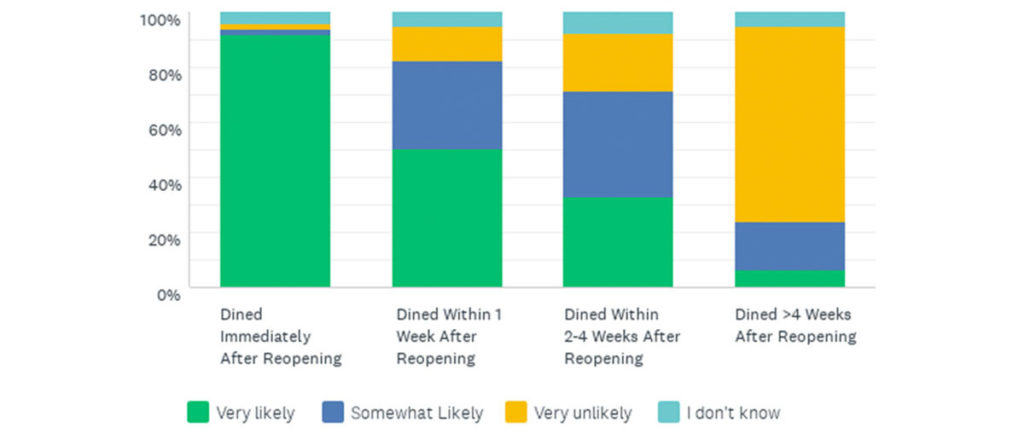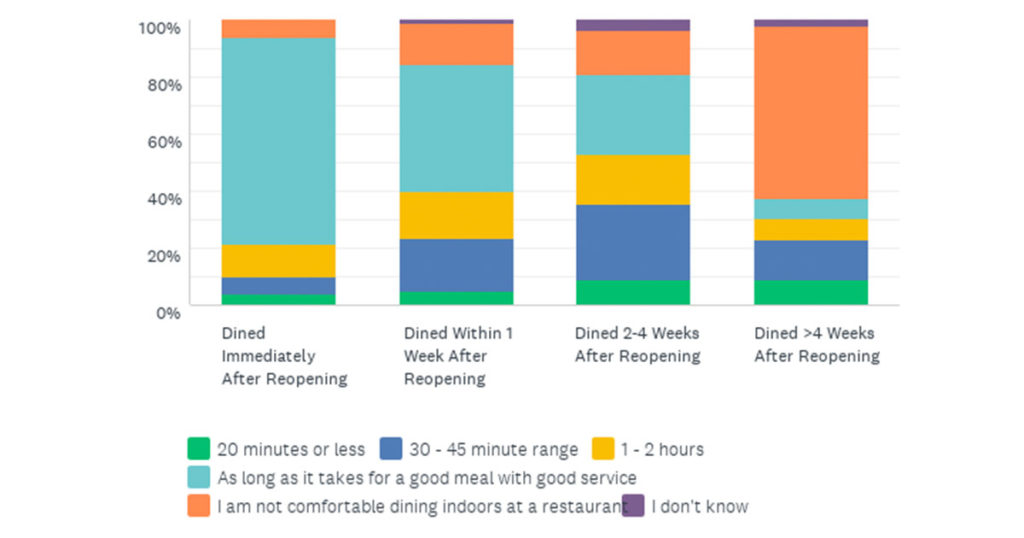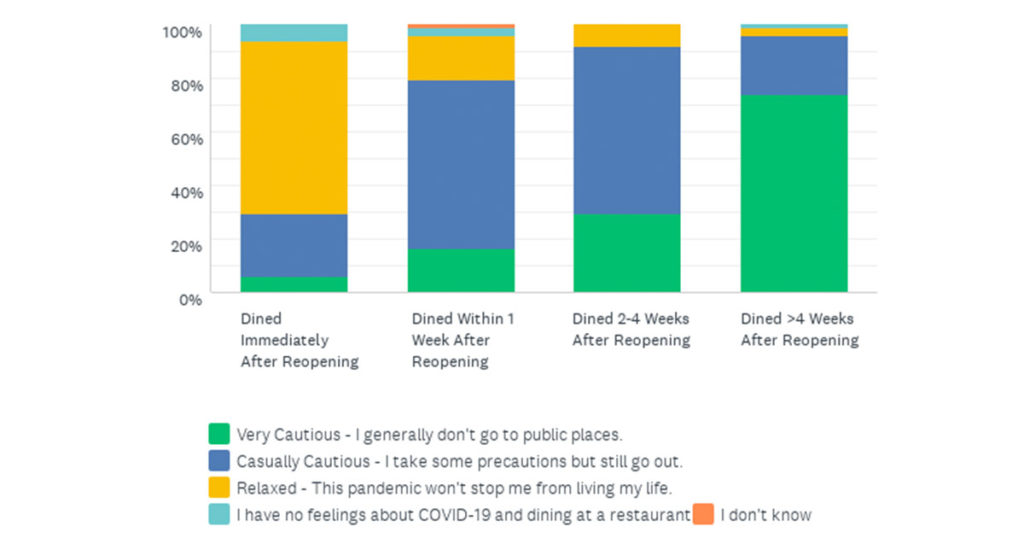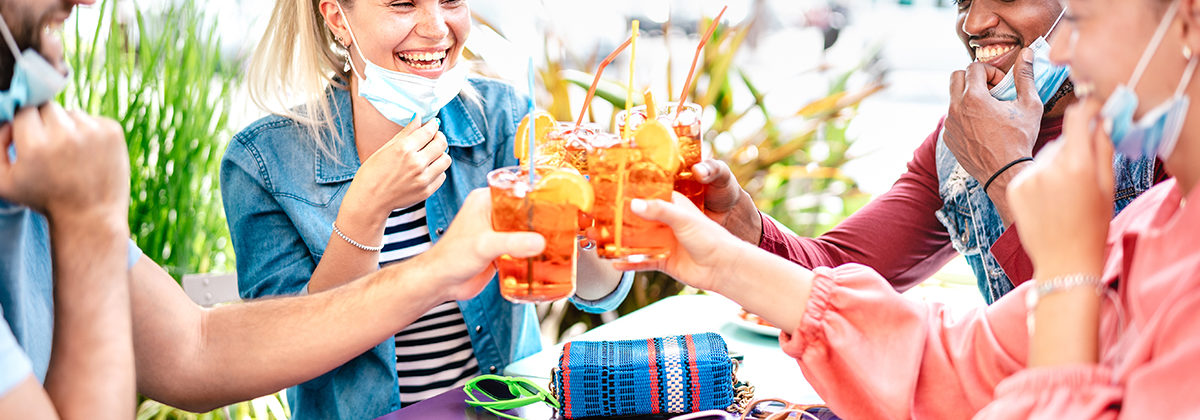Customers First To Dine At Reopened Restaurants More Likely To Dine Again Sooner
A drive to increase dining frequency is key for restaurants to survive the pandemic. This is especially true of those customers that have returned since reopening. Leaning on those customers may be the solution to staying open. How quickly customers return to a reopened restaurant can inform the messaging strategy for driving return visits and to increase dining frequency.
The sooner a customer dines in a restaurant after it reopens, the more likely they’ll dine out again in the next 30 days. Additionally, the less cautious they are of COVID-19 as well compared to those that waited to return. This is according to a recent survey from Response Labs via SurveyMonkey. Information like this provides restaurants an edge on competition and their marketing. How quickly customers return to a reopened restaurant may inform the messaging strategy for driving return visits.
How likely are you to dine out again in the next 30 days?

Source: “Dining at a Restaurant During COVID-19” – Conducted by Response Labs via Survey Monkey on July 13, 2020
Diners during COVID-19 feel differently about pandemic precautions
We surveyed 669 men and women in the United States between the ages of 25-64 who have dined out at a restaurant in the last 30 days. Of those that returned to a restaurant within a week of reopening (23% of all respondents), 87% say they are somewhat or very likely to dine out again in the next 30 days. This group is also less likely to be cautious of COVID-19 when dining out at a restaurant. That may also explain why they do not think a limit on how long the dining experience should last. When asked, “How long are you comfortable being indoors while dining at a restaurant?” 54% said for as long as it takes to get good service.
However, the same questions were asked of diners that did not return to a restaurant until 2 weeks or more after reopening. 56% are very cautious about COVID-19 with 51% saying it was very unlikely they would dine out at a restaurant in the next 30 days. 17% said they are very likely and 26% somewhat likely to do so. Therefore, all is not lost on these customers just because they waited an extra 2-4 weeks to come back. They are more concerned about COVID precautions and are less comfortable with establishments not adhering to mandates. This group was asked, “How long are you comfortable being indoors while dining at a restaurant?”. 60% said they are not comfortable at all being indoors–a contrast to those who returned to restaurants within a week.
How long are you comfortable being indoors while dining in a restaurant?

Source: “Dining at a Restaurant During COVID-19” – Conducted by Response Labs via Survey Monkey on July 13, 2020
Target diners based on how soon they returned to increase dining frequency
As a restaurant marketer you may already employ some data modeling to segment your customers, like an RFM analysis. It may also be wise to separate segments or overlays specifically using a customer’s first transaction in-restaurant since reopening. The messaging may be completely different and the key to engaging them to come back versus feeding into COVID-fatigue. It is exactly the type of content perfect for A/B split testing.
The more immediate diners are less concerned with COVID-19 and more interested in living their life. That includes dining with friends and getting out of the house. Messaging and visuals of people wearing masks or listing precautions may not appeal to them. An image of great food or people laughing together may perform better. However, for the more cautious segment of those that waited to return, the messaging may be different. Leading with restaurant precautions to prevent the spread of COVID-19 may be the only message necessary to increase dining frequency. And increase with you specifically. Additionally, promoting pick up or delivery may provide a great alternative path to transaction. An email journey or SMS offer promoted over the course of a week may entice them to order.
Within a couple weeks of reopening, restaurants can then use the data for creating lookalike audiences to get into the consideration set of new and past customers as well.
Which best describes your feelings about COVID-19 and dining at a restaurant?

Source: “Dining at a Restaurant During COVID-19” – Conducted by Response Labs via Survey Monkey on July 13, 2020
Customer retention versus local competition very important
Overall, how quickly customers return to a reopened restaurant may inform your messaging strategy to increase dining frequency. Customer retention will continue to be important as the pandemic continues. All businesses must take care of their most loyal customers, especially restaurants. With so many options the competition is very steep and the customer has all the control. Getting into their top 3 consideration set is paramount to success. Hopefully the insight from this survey helps forge a more meaningful relationship with your customers through personalization from data. If you would like to learn more about this survey or what Response Labs can do for your business, please contact us here or email our team at info@responselabs.com.
Survey Statistics
- US residents ages 25-64: 168,891,000 (Source: 2019 Census)
- Confidence Level: 95% (Probability that our sample represents the population)
- Margin of Error: 3.8% (Population’s responses may deviate from our sample)
- Sample Size: 669 completed surveys


